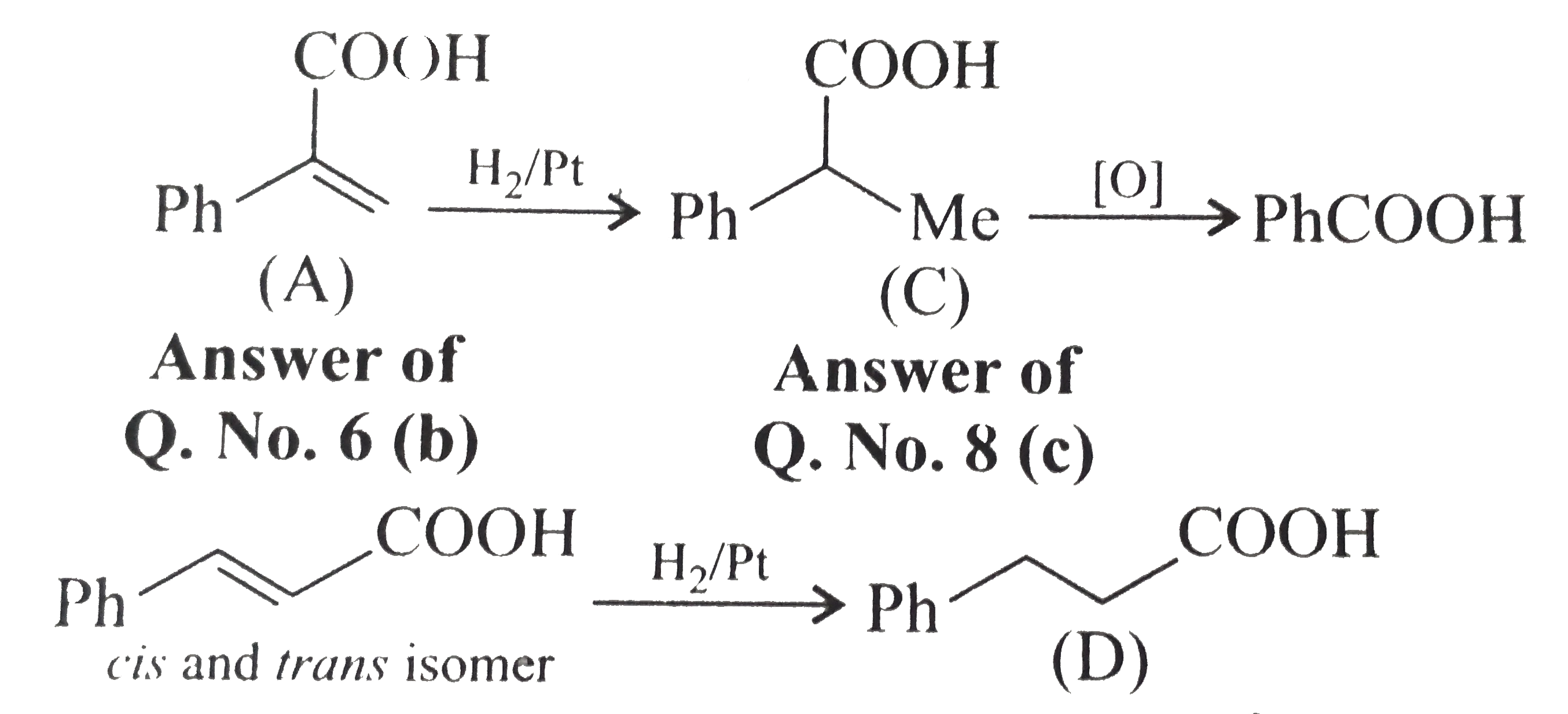
Carboxylic and (B) is :



Both (a) and (c )
The correct Answer is:D
(d) Formation of (E) suggests monosubstituted acid and reaction of 1mol of H2 with (A) and (B) shows one (C=C) bond. There are 6D.U.[4D.U.for(Ph) group, 1D.U. For (COOH), and 1D.U for (C=C)] in both (A) and (B).
Chiral compound with nine C atoms would be 
Reactions :

Here, (C) and (D) can be distinguised quantitatively by H.V.Z reaction (C) has one α−H atom and would give monochlorinaed product, whereas (D) has two α−H atoms and would give dichlorinated product. The chlorine content in the chlorinated derivatives of (C) and (D) is determined by quantative methods.
Topper's Solved these Questions
- CARBOXYLIC ACIDS AND THEIR DERIVATIVESBOOK - CENGAGE CHEMISTRY ENGLISHCHAPTER - CARBOXYLIC ACIDS AND THEIR DERIVATIVESEXERCISE - Exercises (Multiple Correct)
34 Videos
- CARBOXYLIC ACIDS AND THEIR DERIVATIVESBOOK - CENGAGE CHEMISTRY ENGLISHCHAPTER - CARBOXYLIC ACIDS AND THEIR DERIVATIVESEXERCISE - Exercises (Singlecorrect)
64 Videos
- CARBOXYLIC ACIDS AND THEIR DERIVATIVESBOOK - CENGAGE CHEMISTRY ENGLISHCHAPTER - CARBOXYLIC ACIDS AND THEIR DERIVATIVESEXERCISE - Exercises (Subjective)
19 Videos
- BIOMOLECULESBOOK - CENGAGE CHEMISTRY ENGLISHCHAPTER - BIOMOLECULESEXERCISE - Exercises Archives (Analytical And Descriptive)
8 Videos
- CHEMICAL KINETICSBOOK - CENGAGE CHEMISTRY ENGLISHCHAPTER - CHEMICAL KINETICSEXERCISE - Archives Subjective
23 Videos
Similar Questions
Knowledge Check
Assertion : Carboxylic acids do not undergo Friedel - Crafts reaction.
Reason : Carboxyl group is meta-directing group.AIf both assertion and reason are true and reason is the correct explanation of assertion.BIf both assertion and reason are true but reason is not the correct explanation of assertion.CIf assertion is true but reason is false.DIf both assertion and reason are false.
An organic compound (A) (molecular formula C8H16O2) was hydrolysed with dilute sulphuric acid to give a carboxylic acid (B) and an alcohol (C ). Oxidation of (C ) with chromic acid produced (B). (C ) on dehydration gives but-1-ene. Write equations for the reactions involved.
View SolutionAn organic compound (A) (molecular formula C6H12O2) was hydrolysed with dil . H2SO4 to give carboxylic acid (B) and an alcohol (C). 'C' gives white turbidity immediately when treated with anhydrous ZnCl2 and conc. HCl . The organic compound (A) is
View SolutionAn organic compound (A) on treatment with ethyl alcohol gives a carboxylic acid (B) and compound (C). The hydrolysis of (C) under acidic conditions gives (B) and (D). Oxidation of (D) with KMnO4 also gives (B). (B) on heating with Ca(OH)2 gives (E) (molecular formula, C3H6O). (E) does not give Tollens test and does not reduce Fehling's solution but forms a 2,4−dinitrophenyl hydrazone. Identify (A),(B),(C),(D), and (E).
View Solution(a) Explain the mechanism of a nucleophilic attack on the carbonyl group of an aldehyde or a ketone.
(b) An organic commpound (A) (molecular formula C8H16O2) was hydrlysed with dilute sulphuric acid to give a carboxylic acid (B) and an alcohol (C). Oxidatin of (C) with chromic acid also produced (B). On dehydratin (C) gives but-1-ene. Write the equations for the reactions involved.
View SolutionThe inceasing order of the acidity of the following carboxylic acids is :

View SolutionAn organic compound (A) (molecular formula C8H16O2) was hydrolysed with dilute sulphuric acid to give a carboxylic acid (B) and an alcohol (C ). Oxidation of (C ) with chromic acid produced (B). (C ) on dehydration gives but-1-ene. Write equations for the reactions involved.
View SolutionAn organic compound (A) (molecular formula C8H16O2) was hydrolysed with dilute sulphuric acid to give a carboxylic acid (B) and an alcohol (C ). Oxidation of (C ) with chromic acid produced (B). (C ) on dehydration gives but-1-ene. Write equations for the reactions involved.
View Solution

